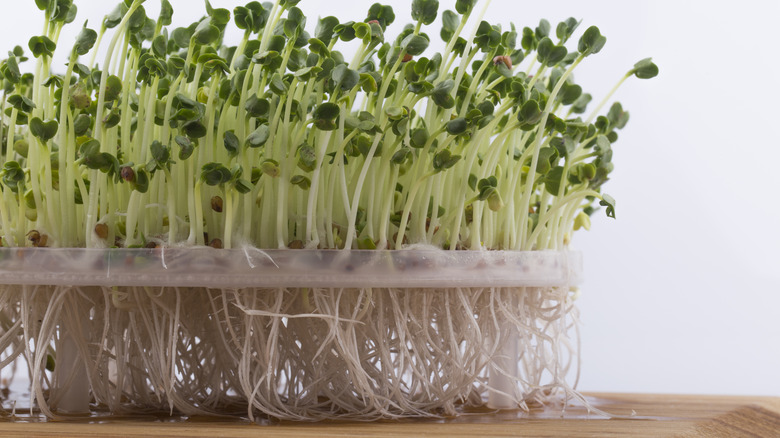Tips For Growing Healthy Broccoli Sprouts & Common Mistakes To Avoid
For both beginner and experienced gardeners looking for fruits and veggies you can grow in your house with little toil and struggle, one of the most interesting prospects are sprouts, including broccoli sprouts. These tiny plants only take a few days to grow and take up barely any counter space. They're perfect for folks without proper gardens or anyone who's looking to grow their own greens with ease.
The best part is — unlike starting seeds indoors for other types of crops — you won't need any fancy shelving units or specific light or darkness levels to produce and reap the benefits of a healthy bunch of sprouts. All it takes is a wide-mouth glass jar with a mesh lid and sticking to the process of rinsing and drying.
If you're already familiar with the steps it takes to grow broccoli sprouts, you may be seeking out tips that'll support their growth and help you avoid any moldy batches. The following tips will help you do just that, as well as avoid common mistakes and misconceptions that come with broccoli sprout gardening at home.
Tips for growing broccoli sprouts successfully
Growing sprouts is relatively simple and easier than cultivating other plants in your garden. In fact, there's no need to grab gloves or a trowel, as these can be sprouted from the comfort of your kitchen. One of the most important tips is purchasing the right seeds in the first place. Not all vegetable seeds are fit for this purpose, and it's best to choose broccoli seeds that are specifically created for sprouting. These are some of the most common sprouting seeds, but plants like radish and alfalfa are also popular.
Another handy detail to keep in mind is the proper storage method. Don't leave your sprouts on the counter or throw them in the fridge on a paper towel. They should be rinsed, fully dried, and stored in an airtight container for the best longevity and the lowest risk of wilting or molding.
If you're a fan of both broccoli sprouts and microgreens, there are even tips for making them healthier, according to Tianbao Yang, a plant physiologist who spoke with the U.S. Department of Agriculture. Growers can mix calcium salt into their water or spray it on their sprouts. They can also expose sprouts to "ultraviolet B (UVB) light for 1–2 hours per day." Both of these methods trigger a higher production of an antioxidant called glucosinolate in the plants, which are healthy for humans to eat.
Common broccoli sprout care mistakes and misconceptions
First and foremost, one of the biggest misconceptions about broccoli sprouts is that they are the same thing as microgreens. This can cause confusion when it comes to growing your sprouts and what sprouts actually are and look like. To clear things up, sprouts consist of the seed and white stalk that emerges from the seed. They grow quicker than microgreens, are smaller, and don't have the same number of green leafy tops that microgreens do. Another difference is that sprouts can grow in nothing more than a jar of water, whereas microgreen growing and care takes a little more cultivation (and soil).
When it comes to growing sprouts, one of the biggest problems stems from not properly aerating them between rinsing. If the sprouts stay too moist, mold can develop and there's a chance it could ruin the whole batch. Creating your own sprouts also requires growers to be sticklers for cleanliness. Contamination can very easily happen and lead to a higher risk of food poisoning from bacteria such as E. coli, salmonella, or listeria. There are a few ways to exercise as much caution as possible, including angling your jar so water continually drains out, washing your sprouts and your hands, checking them for mold and off-putting odors, and drying them with paper towels before you store them.


